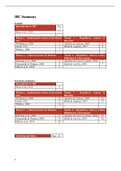IBC Summary
In short
Introduction to IBC Pag
e
Berry et al., 2010 2
Theme 1 – Institutional context & the Dutch Theme 3 – Regulatory context &
case Diversity
Williamson, 2000 2 Aguilera & Jackson, 2003 6
North, 1991 3 Haxhi & Aguilera, 2017 6
Whitley, 2000 3
Theme 2 – Cultural context & Distance Theme 4 – Regulatory context, Codes,
Diffusion & Convergence
Kirkman et al., 2006 4 Aguilera & Cuervo-Cazurra, 2004 7
Drogendijk & Slangen, 2006 4 Haxhi & van Ees, 2010 7
Dikova et al., 2010 5
Extensive summary
Introduction to IBC
Berry et al., 2010 9
Theme 1 – Institutional context & the Dutch Theme 3 – Regulatory context &
case Diversity
Williamson, 2000 10 Aguilera & Jackson, 2003 22
North, 1991 11 Haxhi & Aguilera, 2017 27
Whitley, 2000 14
Theme 2 – Cultural context & Distance Theme 4 – Regulatory context, Codes,
Diffusion & Convergence
Kirkman et al., 2006 17 Aguilera & Cuervo-Cazurra, 2004 35
Drogendijk & Slangen, 2006 19 Haxhi & van Ees, 2010 38
Dikova et al., 2010 20
Learning questions Page 43
1
, Introduction to IBC
Article: Berry, Guillén & Zhou (2010). An institutional approach to cross-national
distance.
Goal:
Disaggregate the construct of distance by proposing a set of multidimensional measures,
including economic, financial, political, administrative, cultural, demographic, knowledge,
global connectedness, and geographic distance. Defining and measuring distance along
multiple dimensions is important because different types of distance can affect firm,
managerial, or individual decisions in different ways, depending on the dimension of distance
under examination.
Existing approaches to cross-national distance are Hofstede’s four measures of culture,
Schwartz’s cultural values framework, Ghemawat’s CAGE framework. However, as there are
critics, this article provided a new theoretical framework with 9 dimensions of cross-national
distance and its indicators.
Article: Isenberg (2008). The global entrepreneur
- More and more start-ups are being born global.
- By tapping resources or serving customers across nations, entrepreneurs can take on
larger rivals, chase global opportunities, and use distance to create new products or
services.
- Two reasons for internationalization: 1) defensive, i.e., be competitive; 2) offensive,
i.e., more opportunities.
- Distances, differences in cultural contexts, the paucity of resources are the main
challenges new ventures face.
- Successful entrepreneurs are clear in their purpose, strike alliances from positions of
weakness, are able to manage global supply chains, and can establish multinational
organizations from the outset.
Theme 1 – Institutional context & the Dutch case
Williamson (2000) - The new institutional Economics; Taking stock, looking ahead
The article argued that institutions are still poorly defined and understood. Williamson argues
that there is a hierarchy by displaying different levels of institutions.
Williamson provides an overview of the previous literature on the topic of New Institutional
Economics and a hierarchical 4-Stage-Model to describe the emergence and structure of
complex institutional systems in a society.
The higher level imposes constraints on the level immediately below. The reversed arrows
indicate that there are opportunities for feedback loops.
Level 1: (informal) cognitive, cultural; spontaneous creation, slow-paced change.
Level 2: (formal) rules of the game; evolutionary process > the definition and enforcement of
property rights and contract laws are important features.
Level 3: (governance) incomplete contracts, TCE and agency, because of frequency,
specificity, uncertainty, bounded rationality (time, info, cognition).
Level 4: (corporate) price and qualities; incentive alignment.
North (1991) – Institutions
With this essay, North aims to elaborate on the role of institutions in the performance of
economies and illustrate his analysis from economic history.
2




